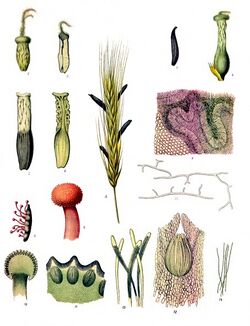Biology:Clavicipitaceae
| Clavicipitaceae | |
|---|---|

| |
| Claviceps purpurea | |
| Scientific classification | |
| Domain: | Eukaryota |
| Kingdom: | Fungi |
| Division: | Ascomycota |
| Class: | Sordariomycetes |
| Order: | Hypocreales |
| Family: | Clavicipitaceae (Lindau) Earle (1901) |
| Type genus | |
| Claviceps Tul. (1853)
| |
| Genera | |
|
See text | |
The Clavicipitaceae are a family of fungi within the order Hypocreales. A 2008 estimate placed 43 genera in the family,[1] but a study in 2020 has increased this number to 50.[2]
Phylogeny
Molecular phylogenetic analysis of multigene DNA sequence data indicates the taxon Clavicipitaceae is paraphyletic, and consists of three well-defined clades, at least one of which is shared with members of another fungal family (Hypocreaceae).[3] The evolution within the Clavicipitaceae is marked by interkingdom host jumping, and the range of this large and heterogeneous fungal group spans mutualistic plant symbionts, as well as parasites of plants, insects, and other fungi.[4]
Significance
Many of its members produce alkaloids toxic to animals and humans. One of its most infamous species is Claviceps purpurea, which has historical significance as the cause of St. Anthony's fire, also known as ergotism. Ergotism is caused by ergot alkaloids, such as ergotamine and ergocristine, which are chemical derivatives of lysergic acid. Metarhizium species are widely used in the biological control of insect pests.[5]
Genera
Several genera, especially those previously described as "anamorphic" (having no known sexual cycle) are now re-classified into other families, in light of current molecular and other evidence. Mycobank currently (July 2018) lists the following genera in this family.[6] With additions (including no. of species) from Wijayawardene et al. 2020.[2]
- Aciculosporium I. Miyake (4)
- Akrophyton
- Albomyces
- Allocordyceps
- Aschersonia Mont. (170+)
- Atkinsonella Diehl (2)
- Atricordyceps
- Balansia Speg. (49)
- Balansiella
- Balansiopsis
- Barya
- Baryella
- Belaina
- Berkelella
- Blistum
- Byssostilbe
- Campylothecium
- Cavimalum Yoshim. Doi, Dargan & K.S. Thind (2)
- Cepsiclava
- Chromostylium
- Claviceps Tul. (111)
- Collarina A. Giraldo, Gené & Guarro (1)
- Commelinaceomyces E. Tanaka (4)
- Conoideocrella D. Johnson, G.H. Sung, Hywel-Jones & Spatafora (3)
- Corallocytostroma Y.N. Yu & Z.Y. Zhang (2)
- Cordycepioideus
- Cordylia
- Corynesphaera
- Diheterospora
- Dothichloe
- Drechmeria
- Dubiomyces
- Dussiella Pat. (3)
- Echinodothis
- Ephelis Fr. (4)
- Epichloe (Fr.) Tul. & C. Tul. (75)
- Epicrea Petr. (1)
- Ergotaetia
- Fleischeria
- Harposporium
- Helicocollum Luangsa-ard (3)
- Helminthascus Tranzschel (1)
- Heteroepichloe E. Tanaka, C. Tanaka, Gafur & Tsuda (2)
- Hypocrella
- Hypocreophis
- Hypoxylum
- Keithomyces Samson, Luangsa-ard & Houbraken (3)
- Kentrosporium
- Konradia Racib. (2)
- Linearistroma
- Loculistroma F. Patt & Charles (1)
- Marquandomyces Samson, Houbraken & Luangsa-ard (1)
- Metapochonia Kepler, S.A. Rehner & Humber (6)
- Metarhiziopsis D.W. Li, R.S. Cowles & C.R. Vossbrinck (1)
- Metarhizium Sorokīn (78) (includes Chamaeleomyces, Metacordyceps, Spatafora, Nomuraea and Stereocrea)
- Mitosporium
- Mitrasphaera
- Moelleria
- Moelleriella Bres. (57)
- Morakotia
- Mothesia
- Mycomalus A. Möller (1)
- MycophilomycesCrous & M.J. Wingf. (1)
- Myriogenis
- Myriogenospora G.F. Atk. (4)
- Neoaraneomyces
- Neobarya Lowen (12)
- Neoclaviceps
- Neocordyceps Kobayasi (1)
- Neotyphodium
- Nigelia Luangsa-ard (2)
- Nigrocornus Ryley & Langdon (1)
- Ophiodothis
- Orbiocrella D. Johnson, G.H. Sung, Hywel-Jones & Spatafora (1)
- Palaeoclaviceps
- Papiliomyces Luangsa-ard, Samson & Thanakitp. (2)
- Parametarhizium
- Parepichloe J.F. White & P.V. Reddy (4)
- Periglandula U. Steiner, E. Leistner & Leuchtm. (2)
- Petchia Thanakitp., Mongkols. & Luangsa-ard (2)
- Phytocordyceps
- Pochonia Bat. & O.M. Fonseca (4)
- Podocrella
- Polistophthora
- Polynema
- Polyrhina
- Pseudomeria G.L. Barron (1)
- Pseudometarhizium
- Purpureomyces Luangsa-ard, Samson & Thanakitp. (3)
- Racemella
- Regiocrella Chaverri & K.T. Hodge (2)
- Romanoa Thirum. (1)
- Rotiferophthora G.L. Barron (27)
- Samuelsia Chaverri & K.T. Hodge (6)
- Shimizuomyces Kobayasi (2)
- Spermoedia
- Sphacelia
- Sphaceliopsis
- Sphaerocordyceps Kobayasi (2)
- Sungia Luangsa-ard, Samson & Thanakitp. (1)
- Tettigorhyza
- Torrubia
- Typhodium
- Tyrannicordyceps Kepler & Spatafora (5)
- Underwoodina
- Ustilaginula
- Ustilaginoidea Bref. (19)
- Ustilagopsis
- Villosiclava
- Wakefieldiomyces
- Xylariopsis
- Yosiokobayasia Samson, Luangsa-ard & Thanakitp (1)
References
- ↑ Dictionary of the Fungi (10th ed.). Wallingford: CABI. 2008. p. 150. ISBN 0-85199-826-7.
- ↑ 2.0 2.1 Wijayawardene, Nalin; Hyde, Kevin; Al-Ani, Laith Khalil Tawfeeq; Somayeh, Dolatabadi; Stadler, Marc; Haelewaters, Danny et al. (2020). "Outline of Fungi and fungus-like taxa". Mycosphere 11: 1060–1456. doi:10.5943/mycosphere/11/1/8.
- ↑ "A multi-gene phylogeny of Clavicipitaceae (Ascomycota, Fungi): identification of localized incongruence using a combinational bootstrap approach". Mol. Phylogenet. Evol. 44 (3): 1204–23. September 2007. doi:10.1016/j.ympev.2007.03.011. PMID 17555990.
- ↑ "Phylogenetic evidence for an animal pathogen origin of ergot and the grass endophytes". Mol. Ecol. 16 (8): 1701–1711. 2007. doi:10.1111/j.1365-294X.2007.03225.x. PMID 17402984.
- ↑ Capinera JL. (2008). Encyclopedia of Entomology. Springer Science & Business Media. pp. 2354–7. ISBN 978-1-4020-6242-1. https://books.google.com/books?id=i9ITMiiohVQC&pg=PA2354.
- ↑ Mycobank: Clavicipitaceae (retrieved 21 July 2018)
Other sources
- C.J. Alexopolous, Charles W. Mims, M. Blackwell et al., Introductory Mycology, 4th ed. (John Wiley and Sons, Hoboken NJ, 2004) ISBN:978-0-471-52229-4
External links
Wikidata ☰ Q672560 entry
 |

